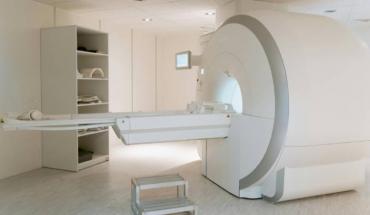Electrophysiological Studies
(EP Study, EPS, Electrophysiology Studies)
Procedure overview
What is an electrophysiological study?
An electrophysiological study (EP study) is an invasive procedure that tests the heart's electrical system. The electrical system of the heart generates the heart beat.
During an EP study, a small, plastic catheter (tube) is inserted through a vein in the groin (or neck, in some cases) and is threaded into the heart, using a special type of X-ray, called fluoroscopy, to guide the catheter. Once in the heart, electrical signals are sent through the catheter to the heart tissue to evaluate the electrical conduction system contained within the heart muscle tissue.
There are several ways in which EP studies may be performed to assist in diagnosing electrical conduction system abnormalities of the heart. For example, a dysrhythmia/arrhythmia (an abnormal rhythm) may be deliberately stimulated by a doctor during the EP study so that the underlying abnormal electrical circuitry can be identified. Likewise, in order to evaluate the effectiveness of an antiarrhythmic medication, an attempt may be made to stimulate the dysrhythmia.
Mapping, another type of EP study, may be done to locate the point of origin of a dysrhythmia. If a location is found that is the cause of the dysrhythmia, an ablation (removal of the spot by freezing or heated radiofrequency waves) may be done, which should stop the dysrhythmia.
The results of the study may help the doctor determine further therapeutic measures, such as inserting a pacemaker or implantable defibrillator, adding or changing medications, performing additional ablation procedures, or providing other treatments.
Other related procedures that may be used to assess the heart include resting or exercise electrocardiogram (ECG), Holter monitor, signal-averaged ECG, cardiac catheterization, chest X-ray, computed tomography (CT scan) of the chest, echocardiography, magnetic resonance imaging (MRI) of the heart, myocardial perfusion scans, radionuclide angiography, and cardiac CT scans. Please see these procedures for additional information.
The heart’s electrical conduction system
The heart is, in the simplest terms, a pump made up of muscle tissue. Like all pumps, the heart requires a source of energy in order to function. The heart's pumping action is regulated by an electrical conduction system that coordinates the contraction of the various chambers of the heart.
| |
| Click Image to Enlarge |
In the heart, an electrical stimulus is generated by the sinus node (sinoatrial node, or SA node), which is a small mass of specialized tissue located in the right atrium (right upper chamber) of the heart.
The sinus node generates an electrical stimulus regularly at 60 to 100 times per minute (for adults) under normal conditions. This electrical stimulus travels down through the conduction pathways (similar to the way electricity flows through power lines from the power plant to your house) and causes the heart's lower chambers to contract and pump out blood. The right and left atria (the two upper chambers of the heart) are stimulated first and contract a short period of time before the right and left ventricles (the two lower chambers of the heart). The electrical impulse travels from the sinus node to the atrioventricular node (also called AV node), where impulses are slowed down for a very short period, then continue down the conduction pathway via the bundle of His into the ventricles. The bundle of His divides into right and left pathways to provide electrical stimulation to the right and left ventricles.
When a problem develops with the heart’s rhythm, there may or may not be any symptoms. The presence of a dysrhythmia is usually determined by an electrocardiogram (ECG). An ECG is one of the simplest and fastest procedures used to evaluate the electrical activity of the heart. By placing electrodes at specific locations on the body (chest, arms, and legs), a tracing of the electrical activity can be obtained.
The electrical activity of the heart is measured by the ECG machine, electronically interpreted, and printed out for the doctor’s information and further interpretation.
How do rhythm problems affect the heart?
One of the most common heart dysrhythmias/arrhythmias is premature ventricular beats, or PVCs. PVCs are just what they sound like: the ventricles beat sooner than they should. This means that the ventricle is contracting and pumping out blood before the atrium above it has completely pumped its blood volume into the ventricle. Most of the time, PVCs are harmless. In fact, almost everyone has them at one time or another. However, if PVCs occur too frequently (more than several times per minute), the heart is unable to pump an adequate volume of blood to the body, which can cause symptoms such as weakness, fatigue, palpitations, or low blood pressure.
Other types of rhythm problems can have similar effects. Problems may occur when the heart beats too fast, too slow, or with an irregular rhythm. But whether the heart is beating too fast, too slow, or too irregularly, the effects are often the same as one or more of those described above. Some additional examples of rhythm problems include:
-
Atrial fibrillation. Occurs when the atria beat irregularly and too fast
-
Ventricular fibrillation. Occurs when the ventricles beat irregularly and too fast
-
Bradycardia. Occurs when the heart beats too slow
-
Tachycardia. Occurs when the heart beats too fast
-
Heart block. Occurs when the electrical signal is delayed or blocked after leaving the SA node. There are several types of heart blocks, and each one has a distinctive ECG tracing.
Some dysrhythmias, however, occur only intermittently, and cannot be seen on a routine ECG or even on a more sophisticated type of ECG, such as a signal-averaged ECG or a Holter monitor procedure (a prolonged recording of the heart rhythm over 24 hours or longer). If the doctor suspects a problem with the heart's conduction system and cannot adequately diagnose the problem with other tests or procedures, then he or she may also decide that an electrophysiology study is appropriate.
Reasons for the procedure
An EP study may be performed for the following reasons:
-
To evaluate a symptomatic patient (a patient having dizziness, fainting, weakness, palpitation, or other symptoms) for a rhythm problem when other noninvasive tests have been inconclusive
-
To locate the source of a rhythm problem
-
To assess the effectiveness of medication(s) given to treat a rhythm problem
-
To evaluate the effectiveness of a pacemaker
There may be other reasons for your doctor to recommend an electrophysiological study.
Risks of the procedure
Possible risks of an EP study include, but are not limited to, the following:
-
Stimulation of more severe rhythm problems
-
Bleeding from the catheter insertion site(s)
-
Damage to the vessel at the catheter insertion site(s)
-
Infection of the catheter site(s)
-
Perforation of the heart (rare)
You may want to ask your doctor about the amount of radiation from the fluoroscopy used during the procedure and the risks related to your particular situation. It is a good idea to keep a record of your past history of radiation exposure, such as previous scans and other types of X-rays, so that you can inform your doctor. Risks associated with radiation exposure may be related to the cumulative number of X-ray examinations and/or treatments over a long period of time.
If you are pregnant or suspect that you may be pregnant, you should notify your health care provider due to risk of injury to the fetus from an EP study. Radiation exposure during pregnancy may lead to birth defects. If you are lactating, or breastfeeding, you should notify your health care provider.
Patients who are allergic to or sensitive to medications or latex should notify their doctor.
For some patients, having to lie still on the procedure table for the length of the procedure may cause some discomfort or pain.
There may be other risks depending on your specific medical condition. Be sure to discuss any concerns with your doctor prior to the procedure.
Before the procedure
-
Your doctor will explain the procedure to you and offer you the opportunity to ask any questions that you might have about the procedure.
-
You will be asked to sign a consent form that gives your permission to do the test. Read the form carefully and ask questions if something is not clear.
-
Notify your doctor if you are sensitive to or are allergic to any medications, iodine, latex, tape, or anesthetic agents (local and general).
-
You will need to fast for a certain period of time prior to the procedure. Your doctor will notify you how long to fast, usually overnight.
-
If you are pregnant or suspect that you may be pregnant, you should notify your doctor.
-
Notify your doctor if you have any body piercing on your chest and/or abdomen.
-
Notify your doctor of all medications (prescription and over-the-counter) and herbal supplements that you are taking.
-
Notify your doctor if you have heart valve disease, as you may need to receive and antibiotic prior to the procedure.
-
Notify your doctor if you have a history of bleeding disorders or if you are taking any anticoagulant (blood-thinning) medications, aspirin, or other medications that affect blood clotting. It may be necessary for you to stop some of these medications prior to the procedure.
-
Your doctor may request a blood test prior to the procedure to determine how long it takes your blood to clot. Other blood tests may be done as well.
-
Notify your doctor if you have a pacemaker.
-
If a sedative is given before the procedure, you may need someone to drive your home afterwards.
-
The area around the catheter insertion (groin area) may be shaved.
-
Based on your medical condition, your doctor may request other specific preparation.
During the procedure
An EP study may be performed on an outpatient basis or as part of your stay in a hospital. Procedures may vary depending on your condition and your doctor’s practices.
Generally, an EP study follows this process:
-
You will be asked to remove any jewelry or other objects that may interfere with the procedure.
-
You will be asked to remove clothing and will be given a gown to wear.
-
You will be asked to empty your bladder prior to the procedure.
-
An intravenous (IV) line will be started in your hand or arm prior to the procedure for injection of medication and to administer IV fluids, if needed.
-
You will be placed in a supine (on your back) position on the procedure table.
-
You will be connected to an ECG monitor that records the electrical activity of the heart and monitors the heart during the procedure using small, adhesive electrodes. Your vital signs (heart rate, blood pressure, breathing rate, and oxygenation level) will be monitored during the procedure.
-
There may be several monitor screens, showing your vital signs and the images of the catheter being moved through the body into the heart.
-
You will receive a sedative medication in your IV before the procedure to help you relax. However, you will likely remain awake during the procedure.
-
Your pulses below the IV site may be checked and marked with a marker so that the circulation to the limb below the site can be checked after the procedure.
-
A local anesthetic will be injected into the skin at the insertion site. You may feel some stinging at the site for a few seconds after the local anesthetic is injected.
-
Once the local anesthetic has taken effect, a sheath, or introducer, will be inserted into the blood vessel. This is a plastic tube through which the catheter will be inserted into the blood vessel and advanced into the heart.
-
One or more catheters will be inserted through the sheath into the blood vessel. The physician will advance the catheter through the blood vessel into the right side of the heart. Fluoroscopy (a special type of X-ray that is displayed on a TV monitor), may be used to assist in advancing the catheter to the heart.
-
Once the doctor has the catheter(s) placed properly, the electrical testing will begin by sending very small electrical impulses to certain areas within the heart. If a dysrhythmia occurs, you may begin to feel lightheaded or dizzy. Medication will be given in your IV to treat the dysrhythmia. Alternatively, a shock will be delivered to stop the dysrhythmia. You will be sedated before this type of shock is given.
-
If a certain area of tissue is found to be causing a dysrhythmia, the doctor may perform an ablation to eliminate the tissue. This is done with radio waves (radiofrequency ablation) or cryothermy (cryoablation). The energy is delivered through the catheter to the tissue.
-
If you notice any discomfort or pain, such as chest pain, neck or jaw pain, back pain, arm pain, shortness of breath, or breathing difficulty, let the doctor know.
-
Once the procedure has been completed, the catheter(s) will be removed from the insertion site. The doctor or an assistant will hold pressure on the insertion site so that the blood can begin to form a clot at the site and stop the bleeding.
-
Once the bleeding has stopped, a bandage will be placed on the site.
-
You will be assisted to slide from the table onto a stretcher so that you can be taken to the recovery area. NOTE: If the insertion was in the groin, you will not be allowed to bend your leg for a few hours. To help you remember to keep your leg straight, the knee of the affected leg may be covered with a sheet and the ends will be tucked under the mattress on both sides of the bed to form a type of loose restraint.
After the procedure
In the hospitalAfter the procedure, you may be taken to the recovery room for observation or returned to your hospital room. You will remain flat in bed for a few hours after the procedure. The circulation and sensation of the limb where the catheter was inserted will be monitored. A nurse will monitor your vital signs, the insertion site, and circulation/sensation in the affected leg or arm.
You should immediately inform your nurse if you feel any chest pain or tightness, or any other pain, as well as any feelings of warmth, bleeding, or pain at the insertion site in your leg or arm.
Bedrest may vary from two to six hours depending on your specific condition.
In some cases, the sheath or introducer may be left in the insertion site. If so, the period of bedrest will be prolonged until the sheath is removed. After the sheath is removed, you may be given a light meal.
You may be given pain medication for pain or discomfort related to the insertion site or having to lie flat and still for a prolonged period.
You may resume your usual diet after the procedure, unless your doctor decides otherwise.
After the specified period of bed rest has been completed, you may get out of bed. The nurse will assist you the first time you get up, and will check your blood pressure while you are lying in bed, sitting, and standing. You should move slowly when getting up from the bed to avoid any dizziness from the long period of bedrest.
When you have completed the recovery period, you may be discharged to your home unless your doctor decides otherwise. If this procedure was performed on an outpatient basis, you must have another person drive you home.
At homeOnce at home, you should monitor the insertion site for bleeding, unusual pain, swelling, and abnormal discoloration or temperature change at or near the injection site. A small bruise is normal. If you notice a constant or large amount of blood at the site that cannot be contained with a small dressing, notify your doctor.
It will be important to keep the insertion site clean and dry. Your doctor will give you specific bathing instructions.
You may be advised not to participate in any strenuous activities. Your doctor will instruct you about when you can return to work and resume normal activities.
Notify your doctor to report any of the following:
-
Fever and/or chills
-
Increased pain, redness, swelling, or bleeding or other drainage from the insertion site
-
Coolness, numbness and/or tingling, or other changes in the affected extremity
-
Chest pain/pressure, nausea and/or vomiting, profuse sweating, dizziness, and/or fainting
Your doctor may give you additional or alternate instructions after the procedure, depending on your particular situation.
Related Questions
Mantoux Test Query
- 3480 Days ago
- Tests & Procedures
My Rheumatoid Factor is - H 74 IU/mL
- 3638 Days ago
- Tests & Procedures
Suffering from piles
- 3759 Days ago
- Tests & Procedures
widal positive
- 3873 Days ago
- Tests & Procedures
Whitish viscosity
- 3882 Days ago
- Tests & Procedures
LINAC procudure, 3DRT and IMRT
- 3896 Days ago
- Tests & Procedures
Ecg of heart showed T wave changes
- 3937 Days ago
- Tests & Procedures
CT Coronary Angiography
- 3921 Days ago
- Tests & Procedures





















